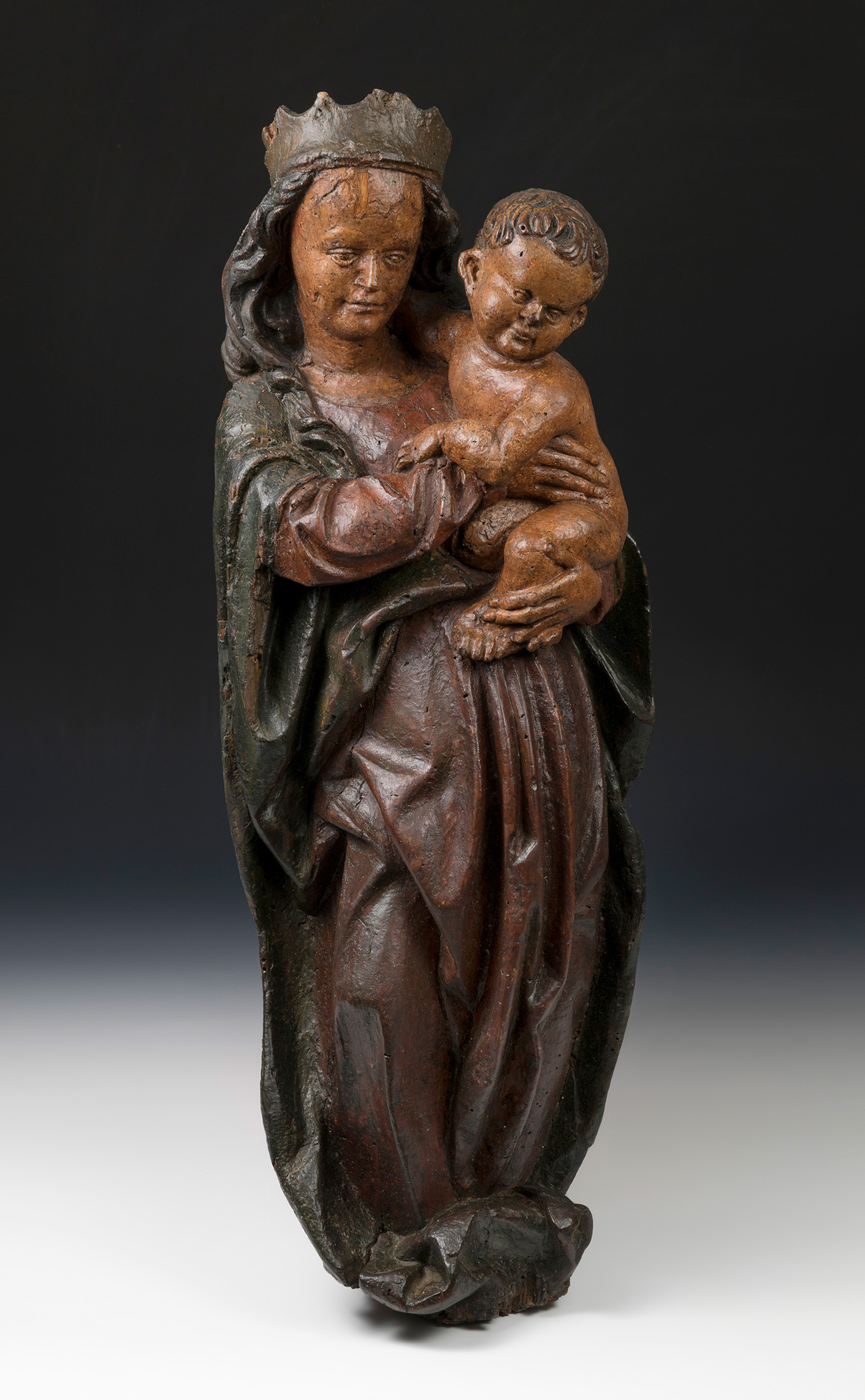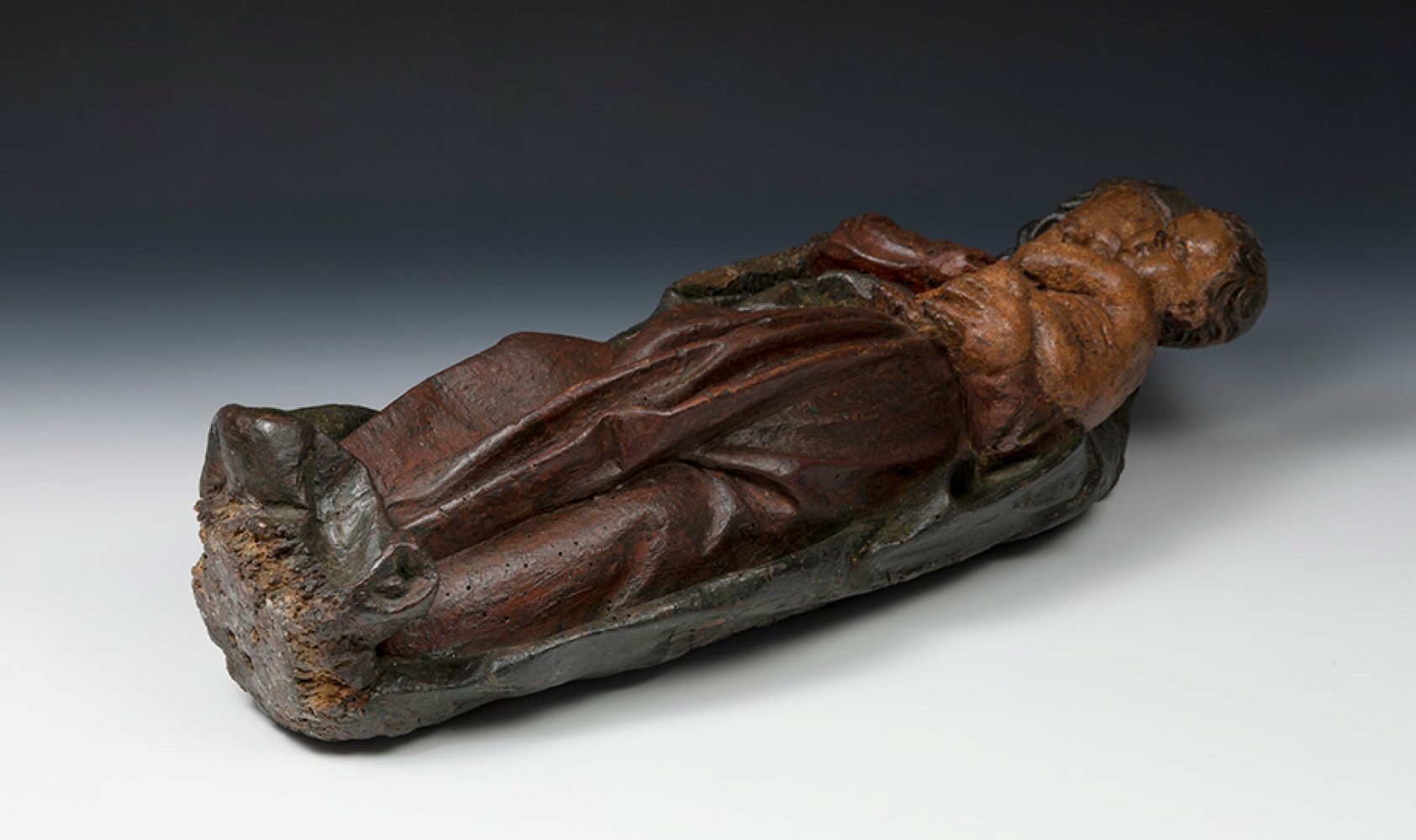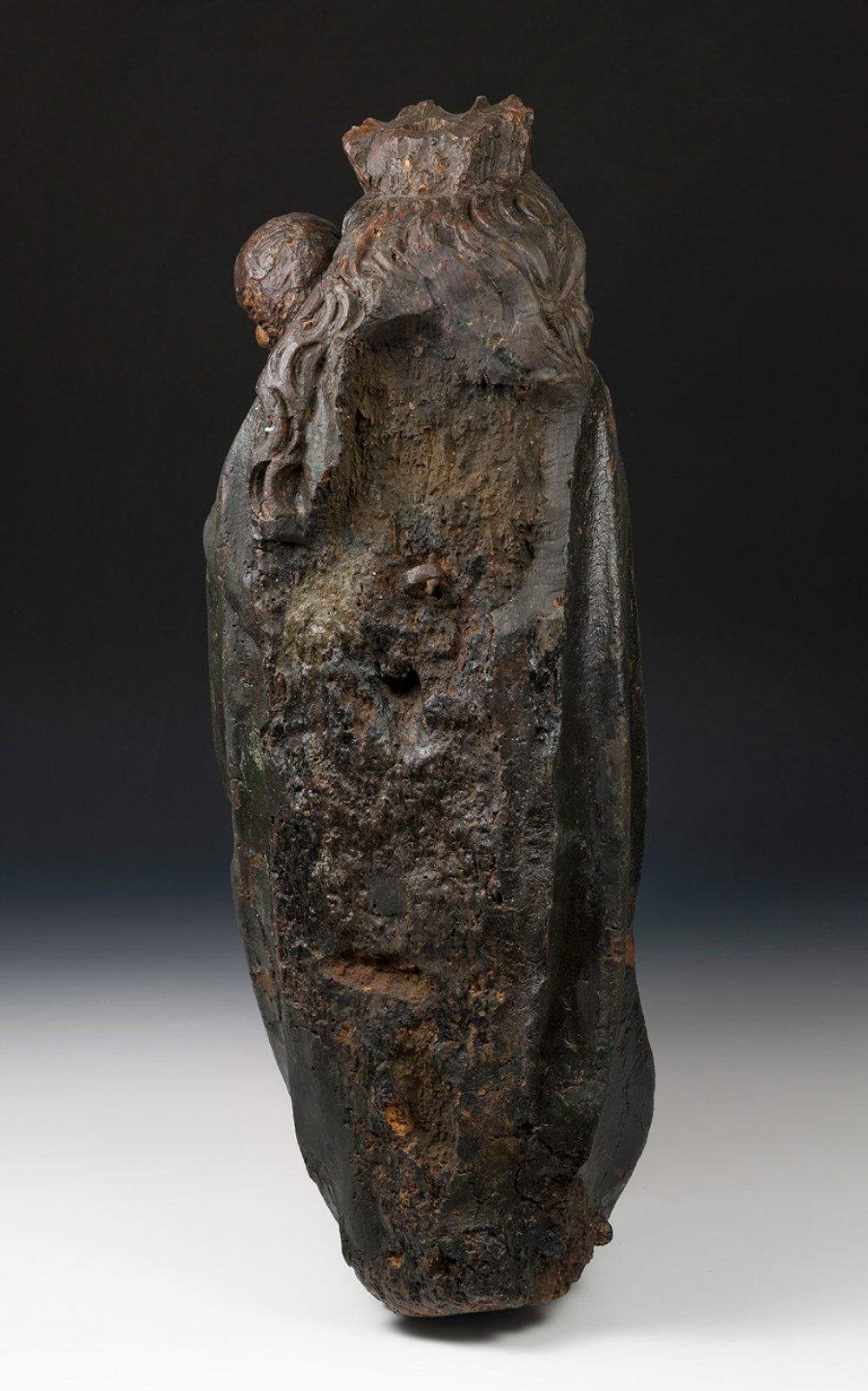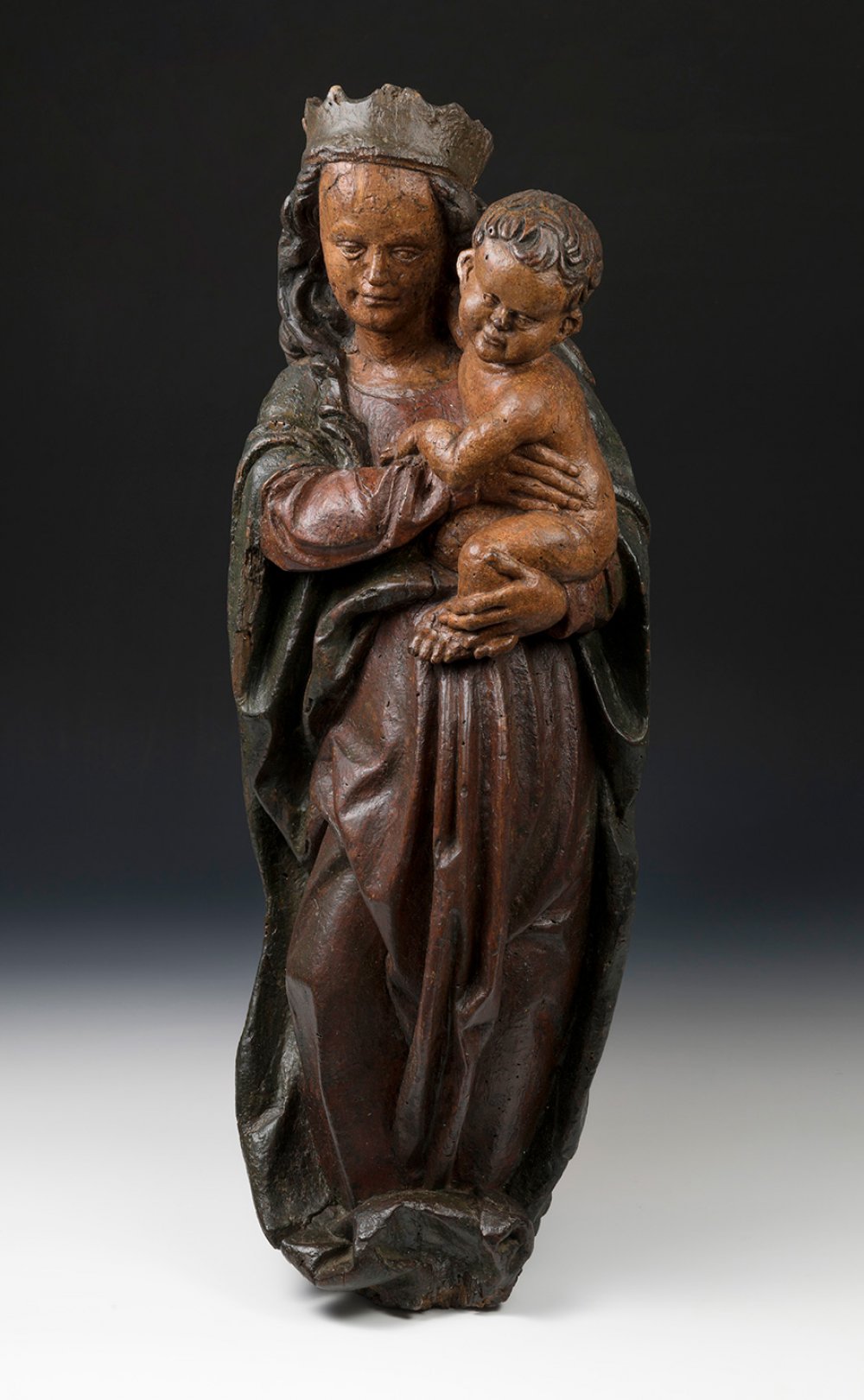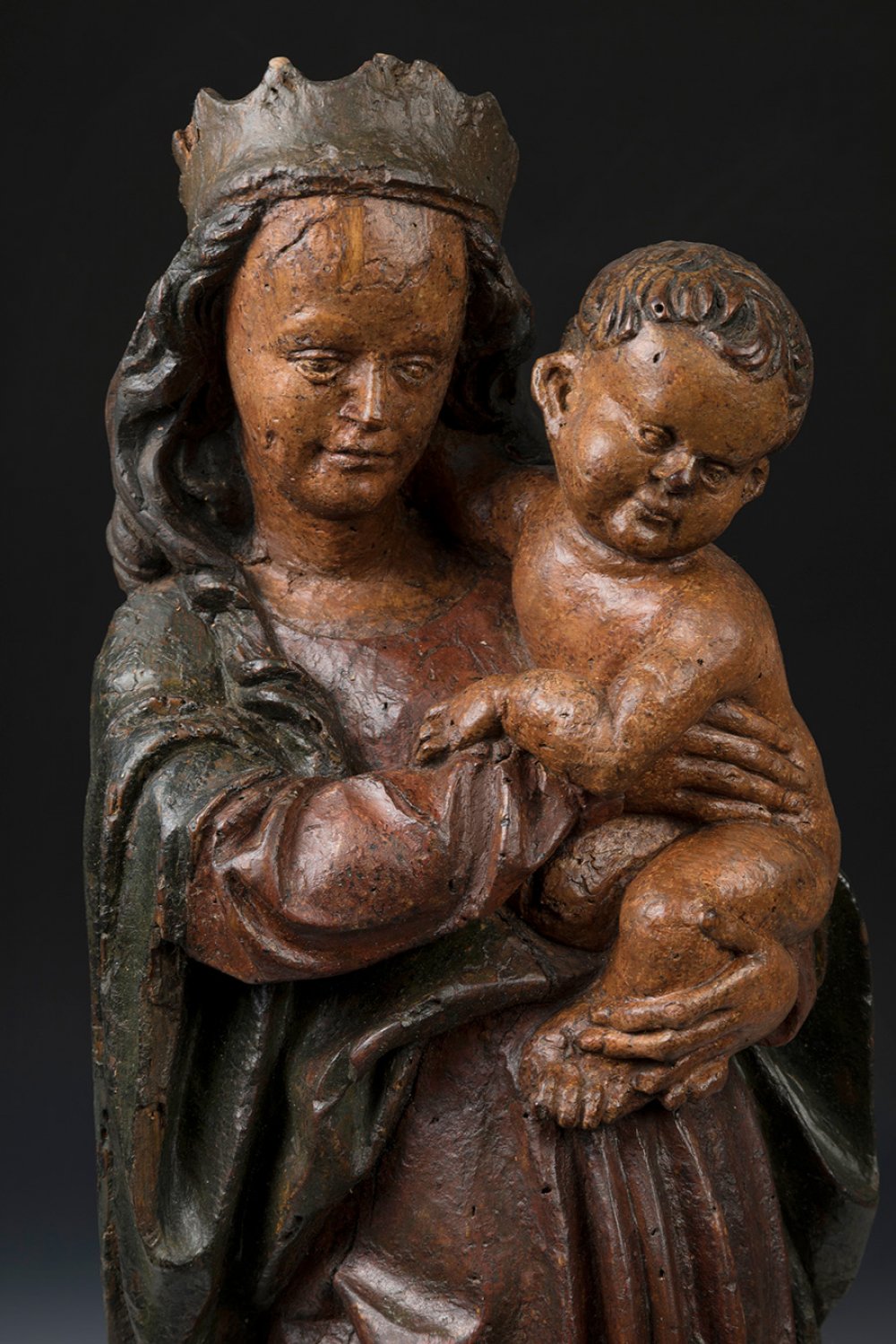59
Spanish school; circa 1500."Virgin and Child".Carved and polychromed wood.It presents faults in
1/5
Description
Spanish school; circa 1500.
"Virgin and Child".
Carved and polychromed wood.
It presents faults in the carving, damage caused by xylophages and polychromy from a later period.
Measurements; 53 x 20 x 12 cm.
Wood carving representing the figure of the Virgin and Child. Mary is standing, holding Jesus in her arms. Both present an accomplice gesture in the embrace, however they do not look at each other, as it is usual during this period, as the transmission of tenderness between them will not take place until later. Aesthetically, it is possible to appreciate the artist's skill in avoiding hieratism, by means of the pompous folds in the tunic and the posture of the bodies of both protagonists.
Sculpture reflects perhaps better than other artistic fields this desire to return to the classical Greco-Roman world, which exalts the individuality of man, creating a new style whose vitality goes beyond mere copying. Anatomy, the movement of the figures, compositions with a sense of perspective and balance, the naturalistic play of folds, the classical attitudes of the figures soon began to be valued; but the strong Gothic tradition maintained expressiveness as a vehicle for the profound spiritualist sense that informed Renaissance sculpture. This strong and healthy tradition favoured the continuity of religious painting, which accepted the formal beauty offered by Italian Renaissance art with a sense of balance that avoided its predominance over the immaterial content that animated the forms. In the early years of the century, Italian works arrived in our lands and some of our artists went to Italy, where they learned the new standards at first hand in the most progressive centres of Italian art, whether in Florence or Rome, or even in Naples.
"Virgin and Child".
Carved and polychromed wood.
It presents faults in the carving, damage caused by xylophages and polychromy from a later period.
Measurements; 53 x 20 x 12 cm.
Wood carving representing the figure of the Virgin and Child. Mary is standing, holding Jesus in her arms. Both present an accomplice gesture in the embrace, however they do not look at each other, as it is usual during this period, as the transmission of tenderness between them will not take place until later. Aesthetically, it is possible to appreciate the artist's skill in avoiding hieratism, by means of the pompous folds in the tunic and the posture of the bodies of both protagonists.
Sculpture reflects perhaps better than other artistic fields this desire to return to the classical Greco-Roman world, which exalts the individuality of man, creating a new style whose vitality goes beyond mere copying. Anatomy, the movement of the figures, compositions with a sense of perspective and balance, the naturalistic play of folds, the classical attitudes of the figures soon began to be valued; but the strong Gothic tradition maintained expressiveness as a vehicle for the profound spiritualist sense that informed Renaissance sculpture. This strong and healthy tradition favoured the continuity of religious painting, which accepted the formal beauty offered by Italian Renaissance art with a sense of balance that avoided its predominance over the immaterial content that animated the forms. In the early years of the century, Italian works arrived in our lands and some of our artists went to Italy, where they learned the new standards at first hand in the most progressive centres of Italian art, whether in Florence or Rome, or even in Naples.
Auction Details
Shipping
T&Cs & Important Info
Ask seller a question
Spanish school; circa 1500.
"Virgin and Child".
Carved and polychromed wood.
It presents faults in the carving, damage caused by xylophages and polychromy from a later period.
Measurements; 53 x 20 x 12 cm.
Wood carving representing the figure of the Virgin and Child. Mary is standing, holding Jesus in her arms. Both present an accomplice gesture in the embrace, however they do not look at each other, as it is usual during this period, as the transmission of tenderness between them will not take place until later. Aesthetically, it is possible to appreciate the artist's skill in avoiding hieratism, by means of the pompous folds in the tunic and the posture of the bodies of both protagonists.
Sculpture reflects perhaps better than other artistic fields this desire to return to the classical Greco-Roman world, which exalts the individuality of man, creating a new style whose vitality goes beyond mere copying. Anatomy, the movement of the figures, compositions with a sense of perspective and balance, the naturalistic play of folds, the classical attitudes of the figures soon began to be valued; but the strong Gothic tradition maintained expressiveness as a vehicle for the profound spiritualist sense that informed Renaissance sculpture. This strong and healthy tradition favoured the continuity of religious painting, which accepted the formal beauty offered by Italian Renaissance art with a sense of balance that avoided its predominance over the immaterial content that animated the forms. In the early years of the century, Italian works arrived in our lands and some of our artists went to Italy, where they learned the new standards at first hand in the most progressive centres of Italian art, whether in Florence or Rome, or even in Naples.
"Virgin and Child".
Carved and polychromed wood.
It presents faults in the carving, damage caused by xylophages and polychromy from a later period.
Measurements; 53 x 20 x 12 cm.
Wood carving representing the figure of the Virgin and Child. Mary is standing, holding Jesus in her arms. Both present an accomplice gesture in the embrace, however they do not look at each other, as it is usual during this period, as the transmission of tenderness between them will not take place until later. Aesthetically, it is possible to appreciate the artist's skill in avoiding hieratism, by means of the pompous folds in the tunic and the posture of the bodies of both protagonists.
Sculpture reflects perhaps better than other artistic fields this desire to return to the classical Greco-Roman world, which exalts the individuality of man, creating a new style whose vitality goes beyond mere copying. Anatomy, the movement of the figures, compositions with a sense of perspective and balance, the naturalistic play of folds, the classical attitudes of the figures soon began to be valued; but the strong Gothic tradition maintained expressiveness as a vehicle for the profound spiritualist sense that informed Renaissance sculpture. This strong and healthy tradition favoured the continuity of religious painting, which accepted the formal beauty offered by Italian Renaissance art with a sense of balance that avoided its predominance over the immaterial content that animated the forms. In the early years of the century, Italian works arrived in our lands and some of our artists went to Italy, where they learned the new standards at first hand in the most progressive centres of Italian art, whether in Florence or Rome, or even in Naples.
29th December - Old Masters
Sale Date(s)
Venue Address
Aragón 346, Barcelona
Calle Velázquez 7, Madrid
Carrer de Cirilo Amorós 55, Valencia
Barcelona
08009
Spain
General delivery information available from the auctioneer
Setdart offers Worldwide shipping
PICK UP IN ROOM: You can come and pick up your lots in our offices (Barcelona, Madrid or Valencia). At the moment of the withdrawal, you will be able to accept the current conditions of the lot by means of a document that you will sign.
YOU CAN SEND ANOTHER PERSON TO PICK UP: This person must present a signed authorization that you can find in our web page by accessing from BUY AT SETDART- LOGISTICS-DOWNLOAD AUTHORIZATION DOCUMENT. You can also send an e-mail with the requested data in AUTHORIZATION DOCUMENT to admin@setdart.com
Important Information
25% buyer´s premium
21% buyer´s premium at www.setdart.com











